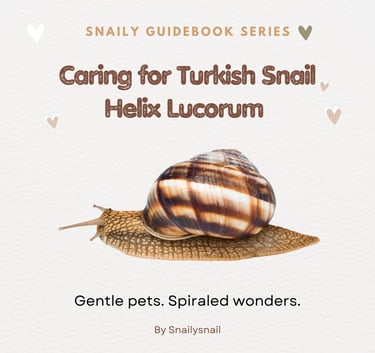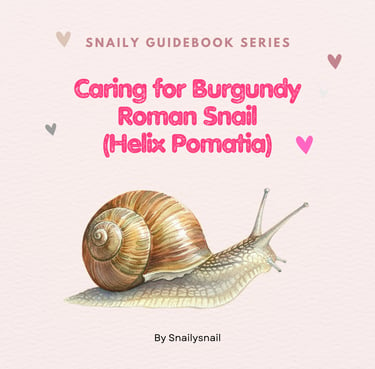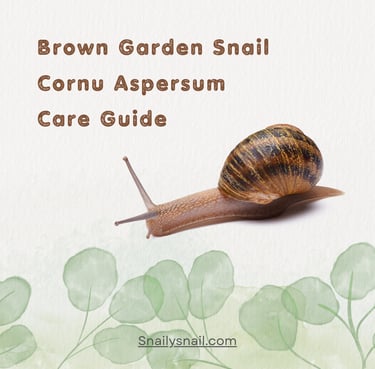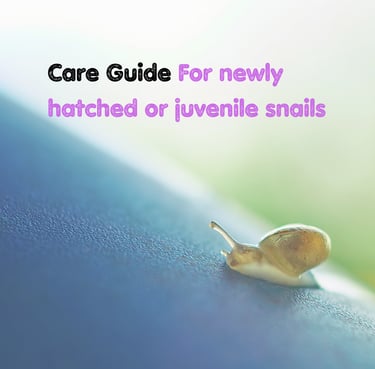We are here to help with your snail care!
Whether you’re a curious first-time keeper or a nature-loving caretaker, you’ve just embarked on a wonderfully slow and fascinating journey. Snails are gentle, unique companions who invite us to slow down, observe, and care more mindfully for the little lives around us.
Our Snail Care books was created to help you give your new friend the safe, enriching home they deserve—from habitat setup and diet, to behavior tips and beyond. Your commitment to learning and caring means the world—not just to your snail, but to the growing community of responsible pet snail lovers.
Snail Care – Common Questions & Answers
What type of enclosure do pet land snails need?
Snails need a well-ventilated terrarium or plastic tank with a secure lid. The enclosure should be escape-proof, maintain humidity, and provide enough space—generally 0.5 to 4 gallons per adult, depending on species. please check land snail comparison chart to choose the size of your enclosure.
The ideal habitat for a pet snail involves a glass terrarium, plastic aquarium, or terrarium offering a secure space for crawling and ample surfaces for climbing. These enclosures are easy to clean and maintain bedding and moisture levels. Use a hygrometer to monitor and adjust humidity as per your snail species' needs. Place a shallow dish of water inside for added humidity and potential bathing. Lastly, include a small shelter within the enclosure to ensure your snail has a private retreat for resting.here are some great options if you are looking to purchase a habitat for your snail friends:
Handmade Glass Box:
Large Geometric Glass Terrarium Box with Swing Lid
High Large Geometric Terrarium
Handmade Glass Gold Terrarium with lid for Snail
Glass Enclosure with Vent Holes for Snails
Acrylic Reptile Terrarium:
Acrylic Reptile Terrarium Enclosure
No Assembly Reptile Tank Enclosure
Acrylic Reptile Breeding Box Terrarium Cage Tank
Portable Clear and Transparent Plastic Tank
What substrate is best for snails?
Use coconut coir, organic soil without fertilizers, or sphagnum moss. The substrate should be kept moist but not soaking wet and should be deep enough for the snails to burrow (at least 2 inches). you can find All-Natural substrates online like these:
All-Natural Loose Coconut Fiber
Organic Compressed Coconut Fiber Substrate
Terrarium Green Sphagnum Moss
Our organic avocado leaf litter also doubles as a nutrient-rich food source, packed with essential vitamins and minerals. Snails will eagerly devour these leaves, indulging in their natural flavors while reaping the nutritional benefits. Plus, their gradual decomposition adds beneficial organic matter to the terrarium soil, enriching it and fostering a thriving ecosystem. Free from harmful chemicals and additives, our avocado leaf litter ensures the safety and health of your pets, providing them with a natural, sustainable, and enriching environment to thrive in.
What's the Best & Safest Woods for Snail Enclosure?
Most snails need daily misting to maintain humidity (between 60–90% depending on species). Always use dechlorinated or spring water to avoid harming them.
What do pet snails eat?
Fresh vegetables (zucchini, lettuce, cucumber, carrots)
Fruits (apple, melon in moderation)
Calcium source like cuttlefish bone, calcium powder without D3, snail calcium or crushed eggshells or oyster shells. Calcium is essential for healthy shell growth and repair. Lack of calcium can lead to fragile, cracked, or deformed shells.
Avoid salty, spicy, processed, or acidic foods like onions or citrus.
Land snails also need a small amount of protein in their diet. You can find special snail food online or use Freeze-Dried BloodWorms, mealworms, or fish flakes. Check what your snail species needs in terms of protein amount and frequency.
We highly recommend Experiencing the difference that our avocado leaf-fed pet and make by choosing our organic leaf litter for your pet-related needs; they are far superior to grocery store-fed.
How do I clean the snail tank?
Spot clean poop and old food daily
Replace substrate and do a full tank clean every 2–4 weeks
Rinse decorations and wipe down the tank with warm water only (no chemicals!)
Can I handle my snails?
Yes, but gently. Wash your hands before and after, and use wet fingers to avoid damaging their bodies. Don’t pull them off surfaces—wait for them to move or gently slide them off.
Are snails safe for kids?
Generally yes, but always supervise. Teach kids to be gentle and wash hands after handling. Some wild snails can carry parasites, but captive-bred pet snails are considered safe with proper hygiene.
Do snails hibernate?
Yes, some temperate species (like Helix pomatia) hibernate during winter. If kept cool and dry, they may enter dormancy. Tropical species don’t hibernate but may aestivate (go dormant) if too dry or hot.
Can I keep nultiple snails together?


Yes—snails are social and peaceful. Make sure the tank is big enough and food is available for all. Avoid mixing species with vastly different care needs.




How often should I mist the enclosure?
Use natural hideout provides a safe space for reptiles, amphibians, or small animals like snails, hermit crabs, hamsters, or geckos to rest, cool down, or de-stress. The smooth yet textured wood encourages natural climbing, rubbing, or burrowing behaviors, while blending seamlessly into naturalistic habitats.
Here are the Best & Safest Woods for Snail Enclosures:
Avocado Tree Bark
Best choice for hiding and climbing, Naturally rot-resistant and mold-resistant, Lightweight and safe. you can find these Avocado Tree Barks from our shop.
Grape Vine Wood
Attractive, safe, and great for climbing, Should be scrubbed and baked to sterilize. Recommend these products:
Premium Sand Blasted Grapevine for Reptiles
Natural California Grapewood
Driftwood (untreated)
Aesthetic and textured for enrichment, Must be freshwater-sourced (not salty/ocean driftwood).
Driftwood for Fish Tanks & Reptile Terrariums
Sand Blasted Grapevine for Reptile
Cholla Wood (dried cactus skeleton)
Lightweight, porous, and fun for small snails to explore, often used in terrariums.
Cholla wood the perfect aquarium driftwood
Cholla Wood Hollow Tube Wood Cactus Skeleton
❌ Woods to Avoid:
Pine, Cedar, Redwood – These contain aromatic oils/resins that are toxic to snails.
Pressure-treated or varnished woods – May release harmful chemicals.
What’s the best plants idea for snail Enclosure?
It is a good idea to keep some live plants in the terrarium. Ivy, ferns and moss are a good choice for a tank where humidity is high and sunlight exposure low. Be aware that your snails may eat these plants and you may have to replace them after a while. Some suggestions for live plants to add to the habitat include: Ferns, which snails will usually avoid and thrive in low-light environments. Ivy, which grows quickly and is generally avoided by snails.
Land Snail Comparison












